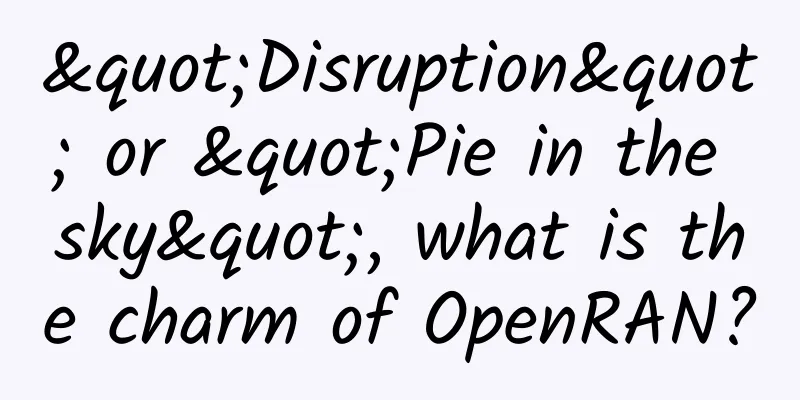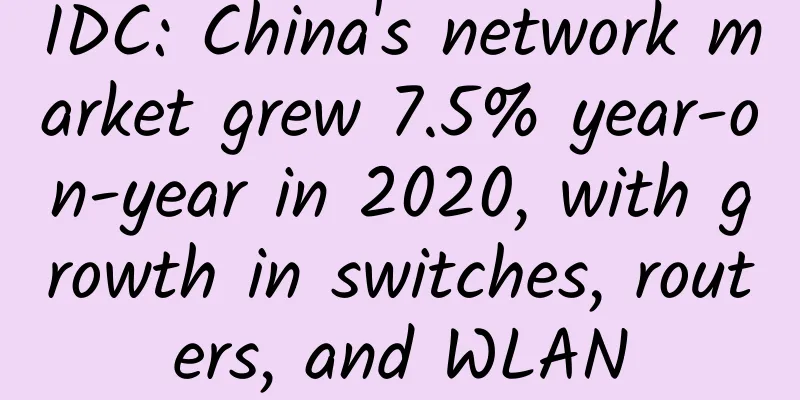"Disruption" or "Pie in the sky", what is the charm of OpenRAN?

|
OpenRAN (Open Radio Access Network) seems to be very popular in the past two years. Recently, the OPS-5G program has pushed it into the spotlight again. OPS-5G is a program launched by DARPA, the high-tech research management agency of the US Department of Defense, in early February this year. It creates open source software and systems to ensure the security of subsequent mobile networks such as 5G and 6G. So, what exactly is OpenRAN? 1. What is OpenRAN? OpenRAN Before introducing OpenRAN, we should first mention TIP. In 2016, Facebook and some telecom operators launched the open source project TIP (Telecom Infrastructure Project) for telecom infrastructure. It is hoped that through this project, telecom operators, infrastructure suppliers, system integrators and other technology companies will be united to jointly develop new technologies and build and deploy a shared telecom network. The TIP project covers three major areas: access network, transmission network and core business network. Currently, TIP has more than 500 members, including operator Vodafone, telecom infrastructure manufacturer Nokia, Internet giant Microsoft and other companies are all members of TIP. OpenRAN is one of the projects of the TIP wireless access project team, currently led by Vodafone and Telefonica. OpenRAN decouples the software and hardware of traditional telecom equipment, opens interfaces and white-boxes hardware, uses general-purpose hardware to replace traditional dedicated equipment, decouples software from hardware suppliers, and enables operators to use software and general-purpose hardware from different manufacturers to achieve modular hybrid networking. OpenRAN is a virtualized RAN solution. Virtualization refers to the ability to emulate a hardware platform in software. All functions are separated from the hardware and simulated as virtual interfaces with similar operating capabilities to traditional hardware. It has the following functional blocks:
The arrival of 5G has added extra impetus to open technologies such as OpenRAN, which is a 5G solution using the OpenRAN architecture. Due to the virtual RAN architecture, 5G OpenRAN can provide most 5G functions, such as network slicing, edge computing, NFV, and massive MIMO. The separation of software and hardware makes RAN more flexible and helps operators provide customized services more cost-effectively. Compared with traditional RAN, OpenRAN has four main advantages: software-defined, unbundled (decoupled control/data open API), programmable and flexible. O-RAN Alliance Echoing OpenRAN is the O-RAN Alliance, which was initiated by China Mobile. In 2018, China Mobile, together with AT&T, Deutsche Telekom, Japan's NTT DOCOMO and France's Orange, jointly launched the O-RAN Alliance. Its vision is to create an "open", "open source" and "intelligent" highly flexible, low-cost wireless network, and conduct research on network intelligence, interface openness, software open source and hardware white box, aiming to bring the openness of the next generation of wireless communication networks to a new level. Although the O-RAN Alliance and OpenRAN belong to different organizations, their goals are the same. The core is to promote the evolution of RAN to a flexible and open architecture. The technical routes and industrial ecology are also similar, but OpenRAN focuses more on the practice and verification of equipment development. TIP and the O-RAN Alliance have reached a partnership, which aims to ensure that the two organizations are consistent in developing 5G RAN solutions to avoid duplication, reduce costs and share resources. 2. What does openness really mean? For all operators around the world, the cost of 5G infrastructure and the cost of maintaining or growing their user base are major issues facing them, which is driving operators towards a more open and collaborative way of working. The emergence of OpenRAN is a key example of this change. The trend of operators embracing and deploying universal, vendor-independent RAN hardware and software is changing the rules of the game. Getting rid of vendor-centric RAN solutions can save operators a lot of costs, break the market monopoly of traditional equipment vendors, avoid being locked in by traditional equipment vendors, reduce costs, improve bargaining power, and achieve a more competitive and dynamic supplier ecosystem. For operators, the move toward a new way of working is good news. Gone are the days of waiting months to deploy new services, features or products. Today, agility is critical for operators, who need the ability to deploy new services quickly and easily. Operators need to be able to move quickly to respond to changing consumer trends. Supporting new use cases – edge computing and network slicing Mobile operators are moving their networks to the edge to enable new latency-sensitive 5G use cases for private networks, venues, dense urban environments, etc. The new open RAN architecture can meet the latency requirements of mobile operators. Open RAN supports 5G network slicing for specific use cases, allowing mobile operators to create multiple virtual networks from a single shared infrastructure to support specific use cases. In the above example, mobile operators can deploy OpenRAN architecture to support highly scalable edge network-based wireless monitoring at the edge to meet the requirements of enhanced mobile broadband and ultra-low latency. 3. Mainstream operators’ support for OpenRAN Vodafone launches first European OpenRAN trial in the UK In early October last year, Vodafone announced that it had launched the first European trial of OpenRAN in the UK, which could be expanded to more markets on the European continent. This move is considered an important milestone because it is the first time that Vodafone has brought OpenRAN to developed regions, and people have seen OpenRAN move from theory to reality. Vodafone is very positive about OpenRAN. The company's CEO said: "We are satisfied with the OpenRAN trial and are ready to quickly promote it to Europe while actively expanding the supplier ecosystem. OpenRAN improves the economics of the network and enables us to serve more rural areas." Subsequently, Vodafone announced a centralized procurement plan for more than 100,000 base stations in 14 European countries at the TIP summit. This move significantly increased the number of wireless network equipment suppliers, but all suppliers participating in the bidding must comply with the technical specifications of the O-RAN Alliance. Vodafone deploys Parallel Wireless’ Macro OpenRAN controller in Türkiye and DRC Parallel Wireless recently announced that Vodafone has deployed Macro OpenRAN in trials in Asia (Turkey) and Africa (Democratic Republic of Congo) with the goal of reducing the cost of deploying and maintaining RAN platforms. Japan's Rakuten Mobile and TPG to test 5G Open RAN in Singapore In February this year, according to foreign media reports, Japan's Rakuten Mobile is working with mobile operator TPG to test 5G Open RAN solutions in Singapore. Rakuten Mobile is building its own 4G mobile network in Japan and claims that it is the world's first end-to-end fully virtualized cloud-native network. This 5G technology cooperation is in line with Rakuten Mobile's open multi-vendor model, which aims to accelerate the adoption of next-generation networks based on open interfaces. Rakuten Mobile said that Open RAN provides a programmable radio access network (RAN) based on a general processing platform (GPPP) and disaggregated software, and operators can benefit from its flexibility and accelerated innovation. On March 5, 2020, Rakuten Mobile, a new Japanese operator that claims to have built the world's first Open RAN, announced that it will officially launch an "unlimited" network service unified package, priced at about half of its competitors. VMware and Intel Help Deutsche Telekom Deploy Open RAN Solution According to foreign media reports, VMware and Intel are helping Deutsche Telekom build a virtualized radio access network (vRAN) platform based on the O-RAN standard for existing LTE and future 5G networks. Several companies are currently conducting tests and verifications at Deutsche Telekom's headquarters. “As traditional RAN evolves towards Open RAN, we need to accelerate the development of scalable, high-performance Open RAN solutions,” said Alex Jinsung Choi, senior vice president of strategy and technology at Deutsche Telekom, in a statement. “Our collaboration with VMware and Intel aims to address the scalability and associated cost issues of vRAN macro layer deployments.” 4. Subvert the market rules of traditional equipment? As mentioned earlier, OpenRAN breaks the "black box" architecture of traditional telecommunications equipment with integrated hardware and software and highly integrated interfaces, allowing operators to use software from different suppliers and providing more options. Mavenir recently commissioned consulting firm Senza Fili to conduct a survey of mobile operators, the results show:
According to the survey results, most operators hope to introduce multiple equipment suppliers to allow more competitors to enter the market, change the current market structure dominated by a few equipment vendors, thereby improving bargaining power and reducing procurement costs. Therefore, views such as "subverting, breaking, and threatening" the existing telecommunications equipment vendor structure have begun to emerge. Does openness mean the beginning of the decline of traditional network equipment giants? The continuous development of OpenRAN may have a certain impact on traditional equipment giants such as Huawei, ZTE, Ericsson, and Nokia, but it may be too early to "break and subvert" them. In some cases, "open" infrastructure may lead to reduced performance. Although breaking vendor lock-in is the main reason for operators to consider using OpenRAN, the complexity of multi-vendor interoperable solutions is also the biggest challenge. In addition, openness will lead to a longer industrial chain, low equipment integration and some other problems:
Huawei's rotating chairman Xu Zhijun also pointed out at the annual report release conference recently that it will take a long time for OpenRAN to solve power consumption, performance, cost and other issues and meet customer needs, and it will have no impact on its business in the short term. Therefore, some people began to question whether OpenRAN is just a "pie in the sky". In comparison, "drawing cakes to appease hunger" or "disrupting and breaking" are too extreme. In fact, the development of OpenRAN and virtualized networks is not for tomorrow and the future, but for the present and the present. Whether OpenRAN can subvert the status quo or eventually become an "alternative RAN" remains to be seen! |
<<: Big news! The three major operators jointly released the "5G Message White Paper"
>>: AI and Wi-Fi 6: Driving the Revolution in Home Wi-Fi
Recommend
What does the battle for AI spectrum mean for 5G?
With the rapid development of smart cities, every...
Why is 5G slow to spread? In addition to being expensive, it is also because of the existence of this 4G package
Time flies, and the promotion of 5G has been goin...
Android Network Programming-TCP/IP Protocol
In the article Android Network Programming - Comp...
Will modularization become the mainstream of edge data centers in the 5G era?
The world is moving from the 4G era to the 5G era...
5G has been promoted for three years, why do some people still insist on using 4G? It turns out that I thought too simply
In recent years, there have been more and more vo...
my country has built the world's largest 4G network
[[181278]] On January 6, the Ministry of Science ...
Interviewer: What process will be executed after entering the URL?
After entering the URL in the browser, it will pe...
Future careers will be completely new and different. What new and mind-blowing jobs will there be in 2018?
The arrival of the New Year is always exciting, e...
Three steps to converge cloud and edge computing for IoT
The Internet of Things has grown rapidly over the...
Five key trends in the Internet of Things in 2017
The Internet of Things (IoT) technology has quiet...
The Importance of PoE in Surveillance and Remote Security Systems
Many devices on the network today, such as IP cam...
In-depth analysis of the difficulties and challenges of 5G core network construction
At present, the core network is in a critical per...
Improve efficiency Essential tools on Mac
[[396744]] There are many useful software on Mac,...
Sorry, goodbye! This operator closed 250 business halls and laid off 3,400 employees. What warning do we have?
This article is reprinted from the WeChat public ...
How are 5G charges calculated: This is what the operators say. Are you willing to pay more?
An operator insider confirmed to IT Times, "...









